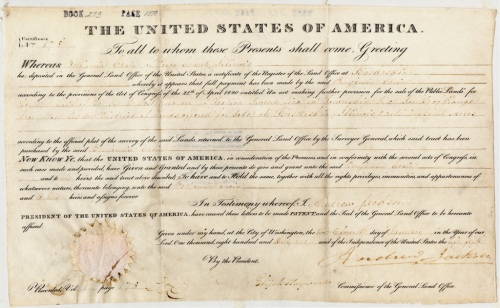
Land patent for Benjamin Crain, Perry County, Illinois, signed January 24, 1831, by President Andrew Jackson
In the early days of the American republic, the President was a relatively accessible figure. Any citizen could shake the President’s hand if he were willing to stand in line long enough at the presidential “levees” that were held weekly by the first three presidents, and thereafter on special occasions such as New Year’s Day. Presidents also held office hours, often daily, when citizens low and high might sit in a waiting room, send in their card or a note stating their business, and hope for a few minutes with the Chief Executive. This tradition continued well after the Civil War, until the nation grew too large and the President’s schedule too complicated.
One of the President’s more mundane duties in those early days was to sign certain routine documents himself, in order to make them legal. Of course this continues for important documents such as Congressional bills and foreign treaties. But early Presidents signed everything from military commissions to ships’ papers to patents for land grants. And the latter, in those days when the federal government was selling the entire frontier in small parcels to individual settlers, became a monumental chore. The flood of western migration, drawn by vast stretches of open land at reasonable prices, meant thousands of individual patents, as the federal deeds were called, every year.
By the early 1830s, the chore had finally gotten out of hand. In June 1832, the commissioner of the general land office wrote to Congress that there were more than 10,500 completed land patents waiting the signature of President Andrew Jackson. Congress passed a law in March 1833 to relieve this burden, authorizing the President to appoint a special secretary to sign land patents–in essence to legally forge the President’s signature. Jackson therefore became the last president to personally sign land grants. If you see one on eBay from a later president, offered as an “authentic signature,” you now know better.
SCRC is fortunate to hold a land patent that Jackson signed himself, issued to Benjamin Crain, of Perry County, in southern Illinois. Born in 1800 in Knox County, Tennessee, Crain moved with his family to Kaskaskia, Illinois, after 1805. By April 1829 the family had settled in nearby Perry County, where Benjamin filed a claim for eighty acres in the west half of the southwest corner of Section 25, Township 6 south, Range 3 west. The parcel lay southwest of the county seat, Pinckneyville, on Four-Mile Prairie, a seven-mile long, four-mile wide stretch of prairie that furnished prime farmland once broken with the plow. Crain set up house there with his new bride Cassandra, after they married in March 1830. He paid off the eighty acres at the price of $1.25 per acre, and President Jackson signed the patent in January 1831.
The Crains prospered on their Four-Mile Prairie farm, raising seven children. The 1860 census valued their farm at nearly $26,000, and Benjamin’s personal wealth at $7,000. The oldest son, James, served in the Civil War, reaching the rank of captain. When Cassandra died in 1878, Benjamin remarried two years later, at the age of 80. He died in 1888 and is buried with Cassandra in Greenbrier cemetery, not far from the farm.
Four-Mile Prairie itself underwent dramatic changes in the late 19th century. Much of its surface was strip-mined to extract coal from rich seams found there. In the mid 20th century, the land was reclaimed to forest and opened to the public as Pyramid State Park. The cemetery, just south of the park, had fallen into disrepair until descendants intervened and restored Benjamin and Cassandra’s tombstone.
As a side note, one of Benjamin Crain’s direct descendants was Virginia Marmaduke (1908-2001), known as “The Duchess,” a pioneer female journalist and longtime reporter for the Chicago Tribune.
I HAVE LAND GRANTS SIGNED BY 3 DIFFERENT PRESIDENTS WITH THE RED WAX SEAL. ARE THEY OF ANY VALUE?
By: mary j weathers on November 26, 2011
at 5:29 pm
I have a land grand signed by Andrew Jackson dated March 5, 1832. The certificate No. is 2917. I would like to know the selling price value. Thank you.
By: michelle cannon on March 8, 2012
at 10:26 pm
According to one expert, an authentic Jackson signed land grant could be worth $2000:
http://www.raabcollection.com/when-presidents-get-tired-of-signing-their-names/
You can find listings online for Jackson land grants from 1832 for $14,000. A lot would depend on authentication and condition. A simple google search will give you a sense of what the market might be.
By: Aaron Lisec on March 9, 2012
at 10:16 am
Thank you.. it is 100% authentic but the condition is not too good. You can make out Jackson’s autograph but it has worn away over the years.
By: michelle cannon on March 9, 2012
at 10:20 am
I have land grant signed by Pres. Fillmore 1851 in excellent condition What might it be worth
By: William Talbott on December 30, 2013
at 10:08 pm
You can get a sense of the market by searching under Fillmore on eBay. The short answer is not much, unless the grant was to someone who has historical significance. Again, after Jackson the presidents did not personally sign these.
By: Aaron Lisec on January 7, 2014
at 12:23 pm
What is the last day in 1833 that Andrew Jackson signed these land grants? I have one from Nov 1833.
By: Mike Meier on December 11, 2023
at 3:36 pm
There seems to be no clear record as to when exactly in 1833 Jackson stopped signing them. Your best bet is to compare the signature to an authentic signature online, preferably one as close to 1833 as you can find. There should be plenty to choose from.
By: Aaron Lisec on December 11, 2023
at 4:23 pm